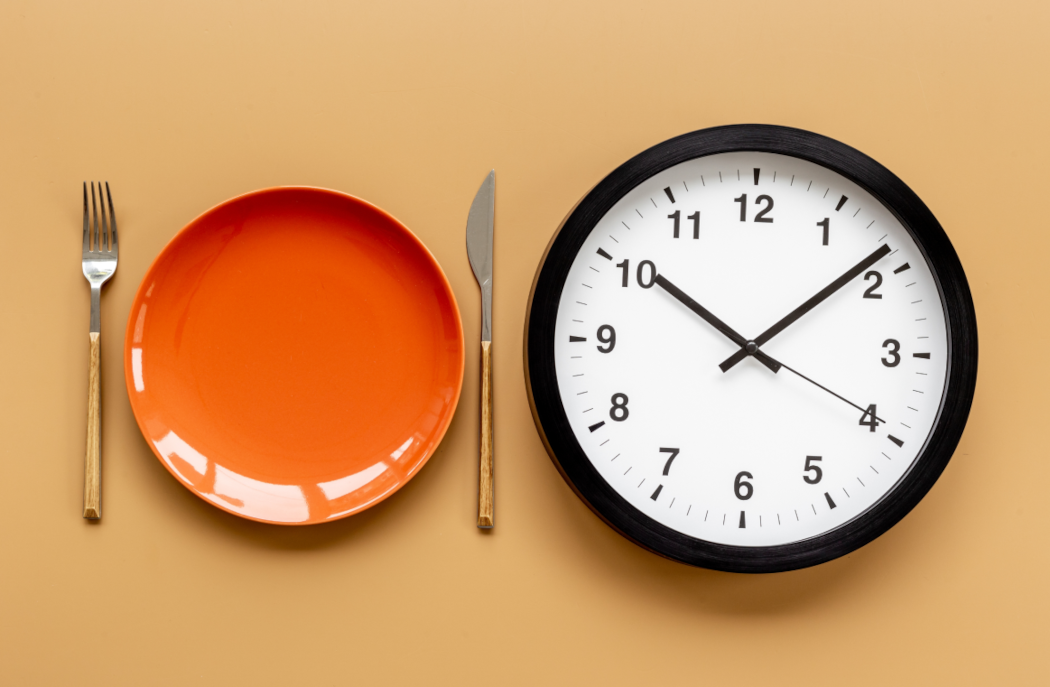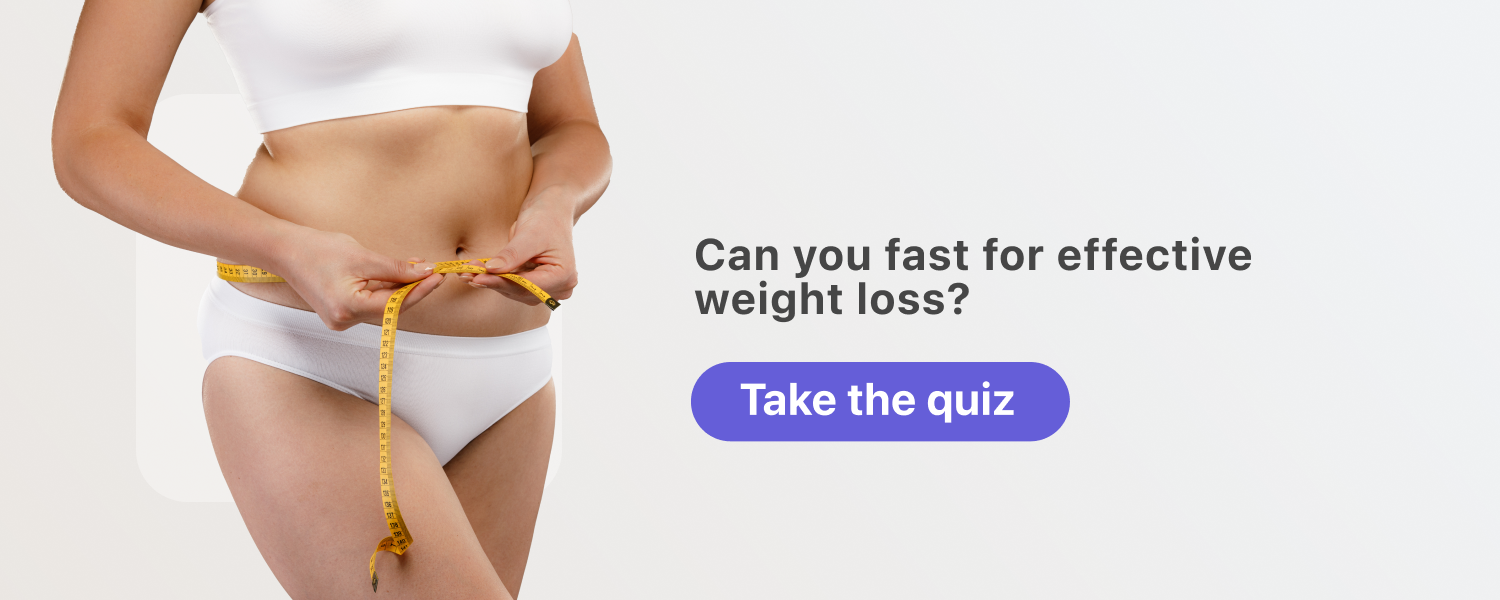Eat Stop Eat: The ultimate beginners guide

So you heard about the Eat Stop Eat method of intermittent fasting:
- two days of 24hr fasting
- five days eating as you wish to
and you’re intrigued.
It’s low on rules, high on flexibility, and the results look promising. Maybe this is the intermittent fasting schedule for you!

Before you can say for sure, you want all the details. Smart move. We’re here for it.
Let’s get into what Eat Stop Eat is all about, its benefits and risks, and how it might fit into your life, so you can decide if this is the approach that’ll make your goals a reality.
What is the Eat Stop Eat intermittent fasting diet?
A quick recap to start:
Intermittent fasting is an approach to health improvement and weight loss that alternates eating and fasting in a structured way.
So, what is Eat Stop Eat?
It’s a method of intermittent fasting which involves two, non-consecutive, 24 hour fasts per week.
That means that two days a week, you’ll eat just one meal. Whether that’s breakfast, lunch, or dinner is up to you, and you can vary it as you wish. An example week might look like this:

The rules of Eat Stop Eat finish there.
You get to choose your fasting days, and there’s no specifications around what to eat on your non-fast days. The founder of Eat Stop Eat, Brad Pilon, claims this is the main reason for why the diet works:
“The simple truth is that it’s very hard to change the way you eat. The Eat Stop Eat method is the simplest way to eat and to live that will help you lose weight and keep it off.”
Is that true?
That’s what we’re going to find out.

So, how does Eat Stop Eat work?
Eat Stop Eat works like any other intermittent fasting method.
- It reduces your caloric intake
By applying the broad brush rule of “no food for X period of time” (in this case 24 hours, twice a week), Eat Stop Eat naturally reduces the amount of calories you eat overall. According to Pilon, just one 24 hour fast could create a 10% calorie deficit.
- It (potentially) shifts your metabolism into fat-burning mode
When you eat through the day on a regular breakfast-lunch-dinner pattern, your body gets the energy it needs from the food you eat.
By contrast, when you fast for 12+ hours, your body has to draw energy from the glucose it has stored on previous days. Once that’s used up, it shifts to burning fat for energy.
This metabolic shift is called ketosis, and specifically targets fat cells.[1] That is part of what helps you to lose weight via fasting (more on this later).
Now, fasting for 12 hours can trigger this metabolic shift, but it may take longer than that. The idea behind Eat Stop Eat is that a 24 hour fast increases the likelihood that you’ll enter a ketogenic state.
Logically this makes sense, but there’s no real evidence to support this claim. Bodies are unique and your body will respond in its own way.
Do you need 24 hours of fasting to hit ketosis? Maybe, maybe not. If you’re new to all this, why not start with 12 and take it from there? We can help you get started — just fill out our SIMPLE quiz.
Eat Stop Eat schedule and meal plan

For Pilon, the Eat Stop Eat schedule maximizes the importance of meal timing, i.e., it’s more about when you eat than what you eat.
The only real advice he gives here is to eat “responsibly”. As long-time intermittent fasting fans here at SIMPLE, we know that to really get the most from intermittent fasting, you gotta pay attention to what you eat and drink.
Let’s pull together a few useful rules of thumb.
Whether it’s a fast day or not, there are certain foods that help you both fast well and get the results you want.
We’re talking about the usual suspects:
- lean protein
- healthy fats
- whole grains
- fruits and vegetables
- calcium rich foods
Your basic mixture of high quality, healthful, minimally processed foods, put together in any way you enjoy.
As far as what you can drink while fasting, the list is pretty short and SIMPLE. On fasting days, stick to:
- water
- tea and coffee with no milk or sugar
Drinking plenty of water will help you stay hydrated (super important when fasting), and water is also one of the best ways to hack hunger while fasting. Keep your water bottle close and refill often!

The Eat Stop Eat method and weight loss
Top dog when it comes to weight loss has always been one thing: creating a calorie deficit.[2]
Compared to having to count calories every day, fasting for 24 hours twice a week could be an easier way to create that deficit sustainably. With two fasting days per week, that’s:
- less meal prep and planning
- less weighing up your options
- fewer days trying to make great food choices
Maybe Eat Stop Eat could give you a leg up on that all-important “eat less than you burn” weight loss principle.
Top that off with the ketosis we already talked about where your body boosts fat-burning (quick recap: you’re fasting, there’s no fuel coming into the tank, so your fat reserves start to get used up), and you can see how this method of intermittent fasting could give you a solid hit on weight loss.
It’s thought to be this metabolic shift that sets intermittent fasting apart from traditional daily calorie-restricted diets.[3] That said, there’s also evidence that suggests that intermittent fasting, while good for weight loss, isn’t any more effective than those traditional daily calorie-restricted diets.[4]
In the end, Eat Stop Eat is no better or worse at stimulating weight loss than any other intermittent fasting method.
But, in the absence of more research on Eat Stop Eat, we’d guide you back to the better studied, more reliable intermittent fasting schedules, like 16:8.
Why not try our SIMPLE quiz? It’ll help you gain some clarity on your goals, suggest a fasting schedule, and be the ping in your pocket that reminds you:
- when to start and stop your fast
- to drink enough water
- to log your food
All the things you need to get into the fasting swing!
Can you exercise on Eat Stop Eat?
Exercising while on the Eat Stop Eat plan is possible. That said, we’d encourage you to take care.
Alongside eating nutritious food, exercise is a wonderful way to maximize your Eat Stop Eat fasting results.
Just go steady as you work it in.
Train when you’re on an eating day so you’re able to replenish your energy, recover well, and satisfy any post-training hunger.
Skip the high-intensity stuff until you’re experienced at fasting and know how your body feels and responds to it.
And always drink plenty of water to keep yourself well hydrated.
Eat Stop Eat results
One way to get good results with intermittent fasting is to start small and work up, like SIMPLE user Jessi did.
You may never need to go to the full extent of Eat Stop Eat, in fact. Solana, another SIMPLE user, got great results with 16:8:
So, if Eat Stop Eat doesn’t appeal, no worries. intermittent fasting can be done in lots of ways.
Health benefits and risks of Eat Stop Eat
Various studies show that intermittent fasting is good for you and can have positive results for health. This could include Eat Stop Eat, but ultimately more studies are needed before we can say for sure.
Benefits of intermittent fasting include:
Reduced inflammation
Chronic inflammation puts you at greater risk for many serious health conditions. Intermittent fasting may improve some inflammatory markers and reduce that risk.[5]
Improved heart health
Through lowering total and LDL cholesterol and reducing blood pressure levels, fasting can support your cardiovascular health.[5,6]
Controlled blood sugar
Research shows that fasting can be effective at reducing insulin resistance and improving glycemic control [7,8], helping people to regulate blood sugar and reducing the risk of type 2 diabetes.
Hormonal changes
Some studies show that intermittent fasting can create hormonal shifts that enhance our health, like reduced insulin, increased human growth hormone, and higher levels of norepinephrine.[9,10] Women with PCOS may also see beneficial hormonal changes.[11]
It’s not all roses, though. Eat Stop Eat comes with its fair share of drawbacks and concerns to be aware of. Risks of Eat Stop Eat include:
Dehydration
Because vegetables and fruits make up a significant portion of your daily water intake, fasting for 24 hours puts you at a higher risk for dehydration, especially if you are very active.
Constipation
Ideally, you need 25-38 g of fiber a day.[12] Hitting your fiber goals can be a challenge when you’ve got a reduced eating window, and fasting for 24 hours could increase your risk of constipation.
All the more reason to get more high nutrition foods in your belly! Eating plenty of whole grains, beans, legumes, nuts, seeds, vegetables, and fruits will help you stay regular.
Disordered eating
Long-term fasting can trigger unhelpful eating habits in some people.
Stay checked in with yourself and your body, and notice if your fasting schedule triggers any eating behaviors that don’t feel good. If it does, reduce your fast or take a break from fasting altogether.
Nutrient deficiencies
With such a long fasting period, some people — especially those with high energy demands — may find it extremely difficult to meet all their nutritional needs on Eat Stop Eat, and that can lead to them becoming deficient in important nutrients.
Hormonal changes
Intermittent fasting and hormones have a complex relationship.
On the one hand, intermittent fasting can cause some beneficial hormonal shifts, as we’ve seen.
On the other, fasting can disrupt hormones too.
For instance, some women may experience increased stress, mood swings, or irregular periods if they fast too often, and intermittent fasting in men can cause a decrease in testosterone.[11]
The initial rough patch
When you first start out with Eat Stop Eat, it might make you feel like a surly, cantankerous, bad-tempered old prune.
You may also feel more tired and dizzier than usual, your head might ache, and of course, you’ll feel hungry. Probably quite a bit hungry.
All this should pass, so don’t sweat it too much. It’s just important you know it’s coming.
Is the Eat Stop Eat fasting method safe?
Like all intermittent fasting methods, Eat Stop Eat is safe, but not for everyone.
Give Eat Stop Eat a miss if you:
- have nutritional deficiencies
- are very active and/or have high daily energy demands
- have (or are at risk of having) an eating disorder, or have a history of one
- have a health condition, like diabetes or anemia
- take medications (especially those which affect blood glucose or blood pressure levels)
- have a Body Mass Index (BMI) in the “underweight” category
- are pregnant, breastfeeding, or trying to conceive
- are under the age of 18, or 80 years old or more
For everybody else, make sure you’re aware of the risks before you give it a go. If you have any concerns, have a chat with your doctor about what might be right for you.
Pros and cons of Eat Stop Eat
| Pros | Cons |
| You control what you eat | 24 hour fasts are loooong |
| No calorie counting | Comes with health risks |
| May help weight / fat loss | Fast days are zero calorie |
| Could improve health | No guarantee of results |
Pros
With Eat Stop Eat, you retain creative control: Your fasting schedule and your food intake are yours to shape in line with your goals and lifestyle. There are no rules except those YOU wish to follow. You don’t have to break out My Fitness Pal and track every calorie you eat.
It’s an approach that can lead to weight loss and fat loss, and it may improve your metabolic health, reducing your risk of various health conditions by reducing your blood pressure or decreasing inflammation in your body.
Cons
Food is a big part of our lives, so a 24 hour fast may clash with your family life, your social life, your workouts, or your work. 0-kcal fasts are tough and hunger will likely be quite the challenge, at least initially.
The freedom from rules, while in many ways liberating, can also be hard work. Oftentimes we don’t know what to eat or how best to approach building healthy habits. All that falls to you to figure out (luckily, though, you’ve got us to help).
Eat Stop Eat also is not without its risks to health. It takes some careful management to ensure you get all the nutrition and hydration you need.
Is the Eat Stop Eat diet right for you?

If you feel a sense of kinship with the idea of two days a week when you don’t have to worry about food, and you feel like you could make a good go of hitting all your nutritional bases on the other five days, Eat Stop Eat could be your intermittent fasting go-to.
It’s flexible, you never have to count a calorie (although getting cozy with nutritional labels to learn the protein content etc., of foods you like is the move of a champion), and it could line up nicely with your health goals.
However, if the idea of a 24 hour fast puts the fear in you, and you yearn for something less… extreme, there’s a bunch of other intermittent fasting options you can try.
Let’s see what you might enjoy:
- 5:2 fasting. The unofficial baby brother of Eat Stop Eat, 5:2 fasting is similar in structure with 2 fast days and 5 eating days, but easier as fast days include 500/600 calories.
- Water fasting. Not really our jam if we’re honest. For sustainable results and safety, water fasting is a no.
- Warrior diet. This intermittent fasting method is a 20 hour fast with a 4 hour eating window, and the warrior diet is an everyday affair. Not for the faint of heart.
- Alternate day fasting. If 5:2 is the baby brother, alternate day fasting is the big daddy. Imagine Eat Stop Eat but on repeat through the week like eat-stop-eat-stop-eat-stop etc., and 500/600 calories on fasting days. (And more evidence to support its efficacy!)
- Intermittent fasting 16:8. A good entry point to intermittent fasting. Intermittent fasting 16:8 is fasting every day for 16 hours. So, every day therefore also contains an eating window of 8 hours.
What takes your fancy?
Simple’s expert opinion and final thoughts
To be completely honest, we prefer intermittent fasting schedules that have shorter fasting windows, like 16:8 or 5:2, over Eat Stop Eat.
It’s easier to support your body’s nutritional needs when you don’t have to muscle your way through a 24 hour period on zero calories. And there’s no real evidence that fasting for 24 hours is any more effective, so why work harder than you have to, with an increased risk to health?
If you’re new to intermittent fasting, we certainly recommend you don’t start here. Instead, hit our SIMPLE quiz. We’ll help you navigate the complex world of fasting and get set up with a plan that suits you.
If you’ve been fasting a while and are curious to see what this schedule feels like, well, now you’re informed. If you decide to explore Eat Stop Eat, listen to your body and pay attention to what you experience. Does fasting this way move you in a positive direction?
Frequently asked questions about the Eat Stop Eat diet
How long should I do Eat Stop Eat?
How long you should do Eat Stop Eat depends on how you respond to this intermittent fasting schedule.
If your body and mind feel good and you’re getting the results you want, keep going. If you don’t feel great, stop and try a different approach.
Can you drink during Eat Stop Eat?
Yes, you can drink during Eat Stop Eat, just as you can drink during any intermittent fasting schedule. When you’re fasting, stick to water, black coffee, and tea without milk or sugar.
How much weight can I lose on Eat Stop Eat?
How much weight you can lose on Eat Stop Eat will depend on how you take action to support your weight loss process. Intermittent fasting is only one piece of the jigsaw in terms of results. If you’re curious how to improve your results, check out these ideas on how to burn fat effectively.
Is Eat Stop Eat the same as alternate day fasting?
Eat Stop Eat is not the same as alternate day fasting (ADF). ADF is fasting literally every other day, which adds up to three or four fasts per week. Eat Stop Eat requires just two fasts per week.
Can you do Eat Stop Eat every day?
Nope, Eat Stop Eat is not an every day fasting plan. Over the period of a week, you complete two 24 hour fasts — on non-consecutive days — and the other five days, you eat.
What are some common intermittent fasting mistakes?
Look no further: We have all the information you need on the most common intermittent fasting mistakes right here, including how to swerve some of the dietary effects you might experience.

- Anton SD, Moehl K, Donahoo WT, Marosi K, Lee SA, Mainous AG 3rd, et al. Flipping the Metabolic Switch: Understanding and Applying the Health Benefits of Fasting. Obesity. 2018 Feb;26(2):254–68.
- Strasser B, Spreitzer A, Haber P. Fat loss depends on energy deficit only, independently of the method for weight loss. Ann Nutr Metab. 2007 Nov 20;51(5):428–32.
- Vasim I, Majeed CN, DeBoer MD. Intermittent Fasting and Metabolic Health. Nutrients [Internet]. 2022 Jan 31;14(3).
- Stockman MC, Thomas D, Burke J, Apovian CM. Intermittent Fasting: Is the Wait Worth the Weight? Curr Obes Rep. 2018 Jun;7(2):172–85.
- Malinowski B, Zalewska K, Węsierska A, Sokołowska MM, Socha M, Liczner G, et al. Intermittent Fasting in Cardiovascular Disorders-An Overview. Nutrients [Internet]. 2019 Mar 20;11(3).
- Dong TA, Sandesara PB, Dhindsa DS, Mehta A, Arneson LC, Dollar AL, et al. Intermittent Fasting: A Heart Healthy Dietary Pattern? Am J Med. 2020 Aug;133(8):901–7.
- Cho Y, Hong N, Kim KW, Cho SJ, Lee M, Lee YH, et al. The Effectiveness of Intermittent Fasting to Reduce Body Mass Index and Glucose Metabolism: A Systematic Review and Meta-Analysis. J Clin Med Res [Internet]. 2019 Oct 9;8(10).
- Vitale R, Kim Y. The Effects of Intermittent Fasting on Glycemic Control and Body Composition in Adults with Obesity and Type 2 Diabetes: A Systematic Review. Metab Syndr Relat Disord. 2020 Dec;18(10):450–61.
- Ho KY, Veldhuis JD, Johnson ML, Furlanetto R, Evans WS, Alberti KG, et al. Fasting enhances growth hormone secretion and amplifies the complex rhythms of growth hormone secretion in man. J Clin Invest. 1988 Apr;81(4):968–75.
- Zauner C, Schneeweiss B, Kranz A, Madl C, Ratheiser K, Kramer L, et al. Resting energy expenditure in short-term starvation is increased as a result of an increase in serum norepinephrine. Am J Clin Nutr. 2000 Jun;71(6):1511–5.
- Cienfuegos S, Corapi S, Gabel K, Ezpeleta M, Kalam F, Lin S, et al. Effect of Intermittent Fasting on Reproductive Hormone Levels in Females and Males: A Review of Human Trials. Nutrients [Internet]. 2022 Jun 3;14(11).
- Heart and Stroke Foundation of Canada. Fibre and whole grains [Internet]. Heart and Stroke Foundation of Canada.
